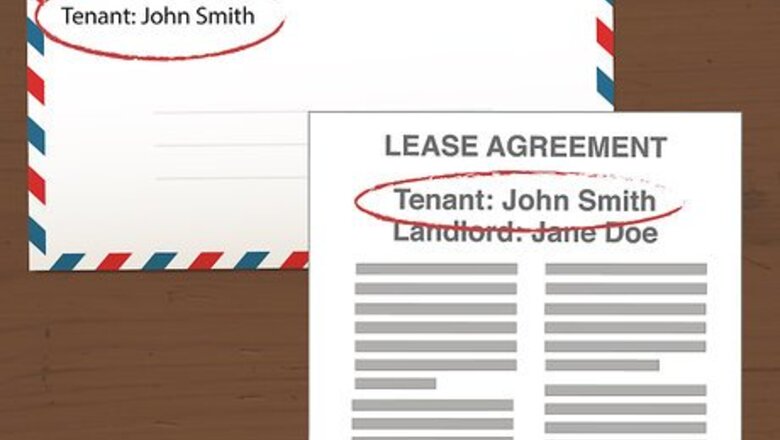
views
Drafting an Eviction Letter
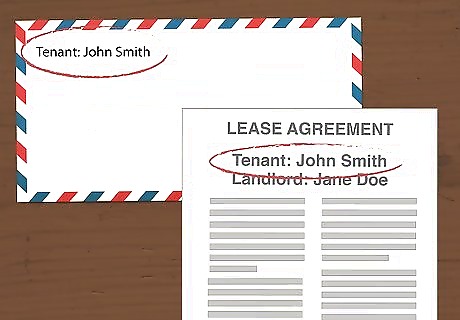
Address the letter to the tenant as named in the lease. Your legal relationship is with the person named in your lease. You need to address your eviction letter to that individual.
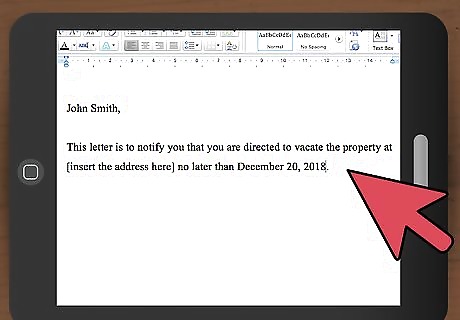
Notify the tenant of the eviction. You need to state, very clearly and concisely, that the purpose of the letter is to evict the tenant. If you try to be too polite or overly cautious in your writing, you may run the risk of confusing the issue. Your letter should simply state, in the first sentence, "This letter is to notify you that you are directed to vacate the property at ___(address)___ no later than ___(date)___."
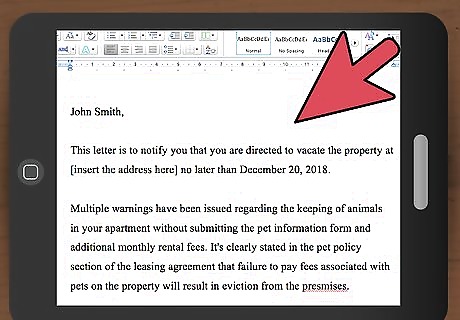
Give the reason for the eviction, such as violating terms of the lease or failure to pay rent. If you are allowing the tenant to remedy the situation and stop the eviction process, state clearly what needs to be done and the date by which it needs to be completed. There are several common reasons for wishing to evict a tenant: Fails to pay the rent on time; Breaks the lease or rental agreement and will not fix the problem (like keeping pets when pets are not allowed); Damages the property bringing down the value (commits "waste"); Becomes a serious nuisance by disturbing other tenants and neighbors even after being asked to stop; or Uses the property to do something illegal.

Be clear and specific. Make sure that your description of the basis for eviction is clear enough to be understood by an uninvolved party. If you allege that the tenant has failed to pay rent, specify the dates that payments were due and the amounts of each one. If you believe that the tenant has damaged the property, clearly identify what has been damaged and what you require to make full repairs. For example, if you are evicting the tenant for failure to pay rent, you might say, "My records indicate that you have missed the following rent payments: May 1, 2015 for $1,250; June 1, 2015, for $1,250; and July 1, 2015, for $1,250. The total amount due is $3,750." If you are evicting the tenant for damages to the property, you may write, "According to Paragraph 8 of the Lease Agreement, you are responsible for maintaining the property in good order. On my last visit to your apartment, on November 13, 2015, I noticed significant burns on the carpet covering about 3 square feet, scratches and tears in the wallpaper, and at least five separate gouges or holes in the living room wall."
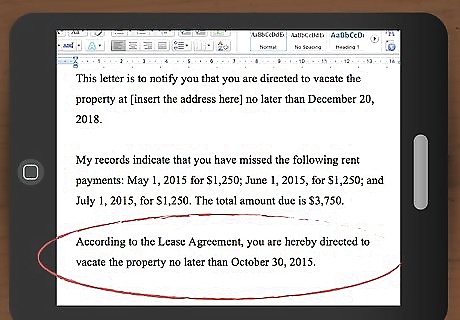
Include the date you want the tenant to vacate the property. Be sure you are within the legal time frame for your jurisdiction. There are state laws that limit how quickly you can demand a tenant vacate the property. The time for eviction usually depends on a combination of the length of the original lease term and the reason for eviction. For example, if the tenant has a 30-day month-to-month lease, you generally need to allow the end of the current month and one full month beyond. For some extreme violations, like commission of a crime or repeated failures to pay rent, you may be able to demand a quicker eviction. After you determine what the law allows for a time frame, set a specific date in your letter: "According to the Lease Agreement, you are hereby directed to vacate the property no later than April 30, 2015."
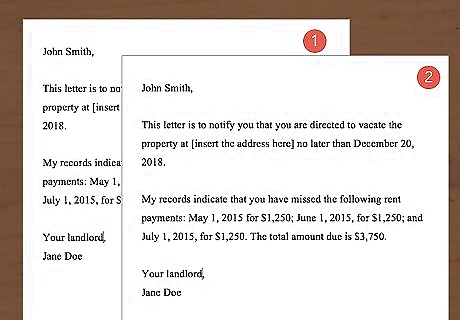
Make a copy of the letter of eviction for your own records. If the situation ends up going to court, you will need to show proof you provided the required amount of time for an eviction notice and followed the law.

Serve the eviction letter to the tenant. Your eviction letter is not valid unless you serve it to the tenant and can later show that you complied with state regulations for service. The easiest method is simply to hand the letter to the tenant in person. However, many tenants may try to avoid service, if they expect such a letter. For that reason, states will allow alternative methods of service. For example, in California, you may either deliver a copy directly to the tenant or leave the notice with someone over the age of 18 at the tenant's residence or place of business. In this second case, you must also send one copy by mail. You can, and should, send a copy of an eviction letter by certified mail. This requires a small fee when you mail it, but then the mail carrier will get a signature from the tenant as proof of delivery. You may also hire a courier service to deliver the eviction letter to the tenant in hand. This requires a slightly higher fee, but provides a higher degree of certainty and proof.
Making Sure you Can Evict your Tenant
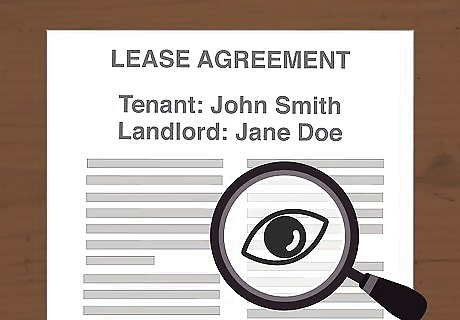
Read the lease carefully. Your relationship with your tenant begins with the written lease. In general, you cannot enforce something that is not already made a part of the lease agreement between you. Before you begin taking any steps to evict your tenant, make sure that you are familiar with all the terms of the lease, and be sure that the lease supports your reason for eviction.
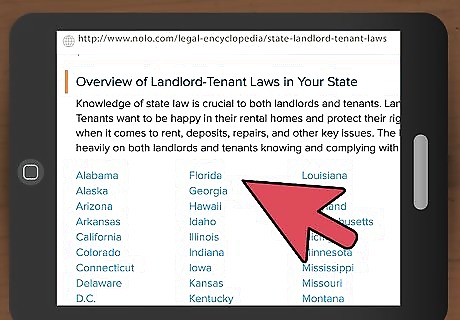
Check state law or local housing regulations. In addition to violating the lease agreement, a tenant may be in violation of some state law or local housing tenant regulation. Each state has its own laws that govern landlord-tenant relationships. You need to become familiar with the laws of your state. A handy site with links to landlord-tenant laws for all 50 states can be found at https://www.nolo.com/legal-encyclopedia/state-landlord-tenant-laws.

Confer with an attorney. If you have any doubt about your right to evict your tenant, you should consult with a real estate attorney. Before you begin taking steps to evict a tenant, you need to be sure that you are acting within the law. If you step beyond your authority, you could cause the tenant to file a counterclaim against you. The law generally places a higher burden on the landlord, because you elected to get into this business.
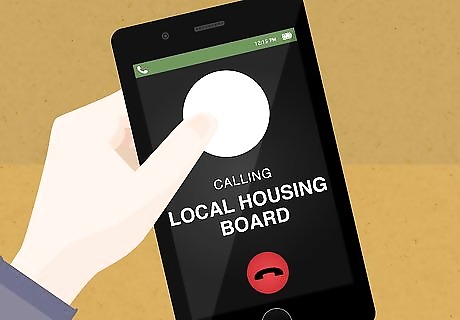
Talk to the local housing board or other authority. Many large cities will have a governmental agency called the housing authority (or some similar title) that sets local regulations. The housing authority also exists to provide moderate legal assistance to landlords and tenants to resolve disputes. For example, the Boston Housing Authority (BHA), Chicago Housing Authority (CHA), and New York City Housing Authority (NYCHA) all have websites that contain information for landlords and tenants.
Trying to Resolve the Dispute Before Eviction

Speak to the tenant directly about the reason. If the reason for eviction is something that could be remedied, you may wish simply to speak with the tenant before taking other action. This is not a legal requirement, but it is a simple step to avoid turning something small into a large legal dispute. For example, if your tenant is not maintaining the property in the way you believe it should be maintained, you and the tenant may just have different standards. If you meet with the tenant and explain your expectations, the tenant may be able to correct the problem. It is a good idea to put your concerns in writing. This is not an eviction letter at this point. It is just a written notice that you would like the tenant to correct some problem. By putting your concern in writing, you will have some evidence later. A sample letter for this purpose would say something like, "On my last visit to your apartment on November 30, 2015, I noticed some unacceptable damage to the living room rug and the wallpaper in the kitchen. These need to be repaired promptly, or I will be forced to take action to evict you."
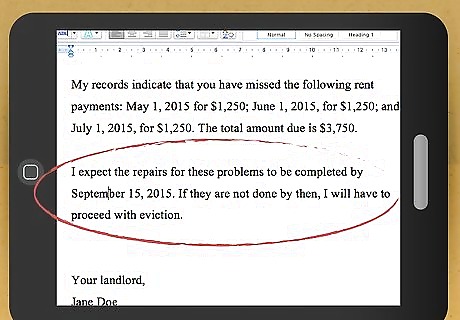
Allow the tenant a reasonable time to remedy the problem. Don't expect the problem to be resolved immediately. When you present the tenant with your concern, allow a reasonable amount of time for the correction to occur. Then, if the tenant does not take care of things, you can proceed with an eviction letter. This time period should be short -- a few days is usually reasonable at this stage. When you submit your actual eviction letter, there will be a requirement for a longer notice period that is usually set by state law. Be clear and precise. Set a specific date, even if you may extend that date later. For example, your letter might say, "I expect the repairs for these problems to be completed by December 15, 2015. If they are not done by then, I will have to proceed with eviction."
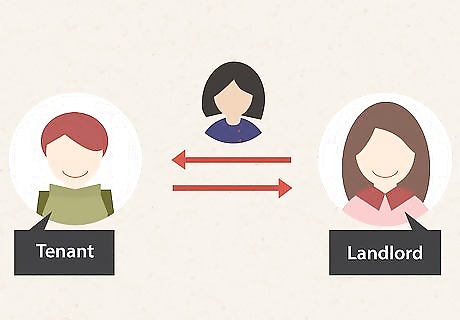
Try a professional mediation. If your reason for evicting the tenant is something clear like non-payment of rent, a mediation may not work. But for a dispute that is less obvious, you may want to consider a mediation session. Mediation is a form of alternative dispute resolution that is often successful in limiting legal action and costs. Contact your housing court or city hall to try to locate a mediation service. Many housing courts or housing authority offices will offer free or low cost mediation services to resolve landlord-tenant disputes.
Getting Rid of a Friend or Family Member

Ask an unwanted guest to leave. This seems obvious, but many people in this situation might skip the obvious first step and jump to legal action. If you have a friend or family member who is staying beyond his or her invitation, you should very simply ask him or her to leave. You can be polite and even allow some time to prepare to go, but you should be clear and firm in your expectation. Say something like, "I've enjoyed having you here, but I believe it is time for you to move on. Please make arrangements to move out by next Friday." This applies equally to your own children, if they have grown but have not moved out yet. If you believe it is time for them to move on and become self-reliant, have a conversation and tell them it is time to go.
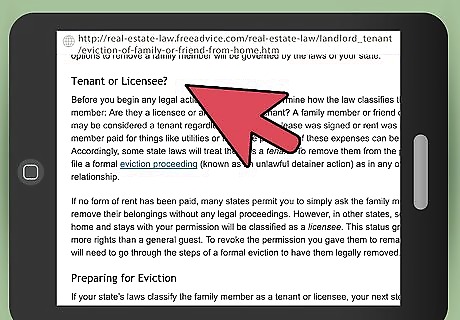
Determine whether a legal lease or tenancy exists. If you have a formal written lease agreement, then it makes no difference if the tenant is a friend or relative. You must still comply with state and local law regarding evictions. However, more likely, you have let someone stay in your place, and they have overstayed their welcome, without a written agreement. In some cases, under state law, a legal tenancy may still exist. If the friend or relative has contributed to living costs, food or utilities, these payments could be considered “rent.” Under state law in some states, this could be enough to create a legal tenancy. You will need to consult with a local real estate attorney.
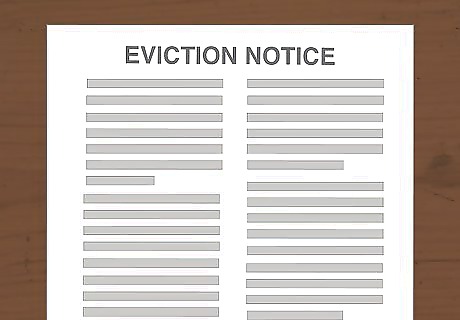
Proceed with legal eviction notices, if a tenancy exists. If you decide that a legal tenancy has been created, or if you just want to be cautious, you should proceed with the steps toward a formal eviction. That would include writing and delivering an eviction notice as outlined here. In such a case, you would treat the individual's tenancy as a month-to-month tenancy for 30 days at a time. This will help determine the amount of notice time you must provide.
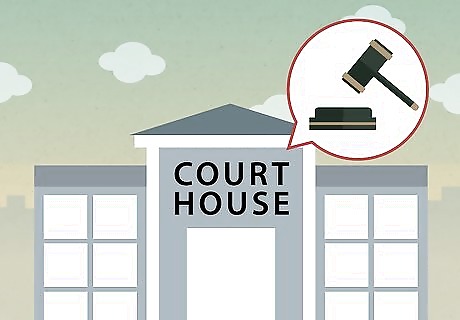
Proceed with an unlawful detainer hearing. This is a hearing in court, in which you present the facts to a judge and ask for an order for the individual to leave. You will need to prove that you are the owner of the property and that the friend or relative has no legal right to remain in the property. If you succeed at the unlawful detainer hearing, the judge will issue a date for the friend or relative to leave the property. If he or she does not leave by that time, you will be able to contact the local sheriff, show him or her the order, and the sheriff will remove the individual by physical force if necessary.
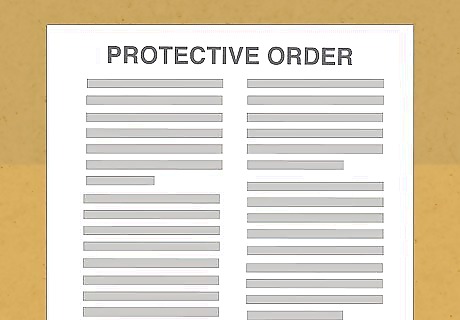
Consider applying for a protective order. If the friend or relative is abusive toward you and makes you fear for your safety, you can go to court to request a protective order. If applicable, a protective order can be granted immediately, without any of the waiting periods connected with eviction. If you are successful in obtaining a protective order, it is advisable to proceed with formal eviction steps anyway. Even though the individual is out of the house, you should send a formal eviction notice and follow the remaining steps to make the eviction final.
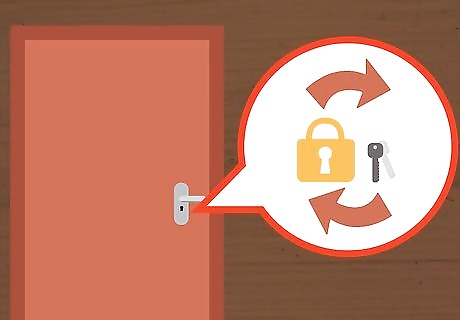
Engage in “self help” if you are sure there is no legal tenancy. If you are certain that the person in your house has no legal tenancy right (you should consult with an attorney before reaching this conclusion), you may engage in what is called “self help.” You are allowed to take whatever steps you consider necessary to get the person out of your home. These may include changing the locks or moving his or her property to a commercial storage facility. Be careful if you choose to take these actions. If you are wrong about the tenancy, you could be facing a lawsuit against you for wrongful eviction. If you engage in self help to remove property, the individual could charge you with damaging or losing any property. You should be careful to keep an inventory and have a witness when dealing with other people's property in this way.

















Comments
0 comment